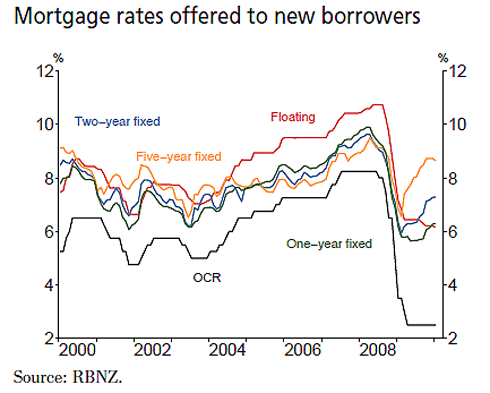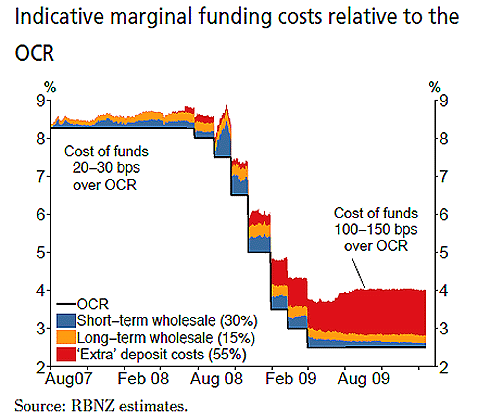 By Bernard Hickey
Here's the short version: It's now clear that the landscape for interest rates in New Zealand (and globally) has now changed for years to come. Variable mortgage rates are now likely to be significantly cheaper than fixed rates for long periods of time, long enough to make it worthwhile to switch to variable rates to consistently get the best deal. Some may choose fixed rates to be sure of their outgoings, but those looking for the cheapest rate for the longest period are probably now best off floating. This is a change to a landscape that has been in place for almost a decade.
Here's the long version: New Zealand home owners have assumed for years that fixed mortgage rates are usually cheaper than variable rates and that choosing to fix is the default option. The only doubt in the past was for short periods at the margins when interest rates were falling fast or there was some temporary hiccup in the market. Sometimes borrowers would choose to float as rates were falling and then aim to 'pick the turn' and jump back onto fixed rates.
But what if something fundamental changed that meant New Zealand's variable rates were usually cheaper than fixed rates for years on end? I've held back for months from even suggesting this given the New Zealand mortgage market's history for most of the last decade. We're a nation addicted to fixed rate mortgages, but I think it's now time to seriously considering floating for the long term to get a better deal.
By Bernard Hickey
Here's the short version: It's now clear that the landscape for interest rates in New Zealand (and globally) has now changed for years to come. Variable mortgage rates are now likely to be significantly cheaper than fixed rates for long periods of time, long enough to make it worthwhile to switch to variable rates to consistently get the best deal. Some may choose fixed rates to be sure of their outgoings, but those looking for the cheapest rate for the longest period are probably now best off floating. This is a change to a landscape that has been in place for almost a decade.
Here's the long version: New Zealand home owners have assumed for years that fixed mortgage rates are usually cheaper than variable rates and that choosing to fix is the default option. The only doubt in the past was for short periods at the margins when interest rates were falling fast or there was some temporary hiccup in the market. Sometimes borrowers would choose to float as rates were falling and then aim to 'pick the turn' and jump back onto fixed rates.
But what if something fundamental changed that meant New Zealand's variable rates were usually cheaper than fixed rates for years on end? I've held back for months from even suggesting this given the New Zealand mortgage market's history for most of the last decade. We're a nation addicted to fixed rate mortgages, but I think it's now time to seriously considering floating for the long term to get a better deal.
 Reserve Bank Governor Alan Bollard said in the bank's March Monetary Statement (MPS) on March 11 that he now expected bank funding costs to remain elevated for a long time, partly because of increased competition for funds globally and because of moves by regulators to restrict access to the cheap 'hot' money that helped keep longer term fixed rates lower than floating rates in the past.
The Reserve Bank estimated in its MPS that these higher bank funding costs had increased to about 150 basis points (1.5%) over the Official Cash Rate in the last two years, up from around 20-30 basis points before the global financial crisis. This extra cost has effectively been bolted on to the cost of fixed mortgages. As the chart above shows, fixed mortgage rates have been rising for over a year (see blue 2 year fixed line) while floating rates (red line) have been falling.
So why has this happened and can it last? What was the shift in the tectonic plates of the financial world that turned New Zealand's yield curve upside down so it is now upward sloping? The simple answer is the Global Financial Crisis that started in March of 2008 changed everything and is still rumbling through the system. It could rumble for at least another 5-10 years.
The previous structure of interest rates globally and locally was just not sustainable. Essentially, the US Federal Reserve dragged short term interest rates down to near 1% for much of the period after 9/11/2001, which encouraged many banks in the Northern Hemisphere to go on a lending spree, helped along by fancy new securitisation vehicles and aggressive investment bankers in Manhattan and Canary Wharf. This massively increased the leverage of many banks globally and swamped the world with 'hot money.'
Some of that money ended up in New Zealand because our big four banks chose to fund a good chunk of their mortgage lending here from 2002 to 2008 by borrowing in those 'hot money' markets for short terms. Then the financial crisis hit and those 'hot money' markets dried up. Our banks got by through late 2008 and early 2009 with some help from the Reserve Bank, their parents in Australia and by slowing their lending.
Not so much 'hot money'
The markets are opening up again, but now regulators and Reserve Banks are keeping a tight rein on the banks. They are being forced to scale back their leverage and to borrow for longer terms so they don't have to rely on these 'hot money' markets so much in future.
This is proving more expensive for the banks. The Reserve Bank of New Zealand was the first of the central banks to bring in a 'liquidity policy' which sets a target for the banks known as a 'Core Funding Ratio.' This specifies that the banks must have 65% of their funding from stable sources such as local term deposits or from long term wholesale funds. This ratio is set to ramp up to 75% over the next couple of years.
This chart here from the Reserve Bank shows the extent of these higher funding costs and how they've increased. These increased funding costs are not going away.
Reserve Bank Governor Alan Bollard said in the bank's March Monetary Statement (MPS) on March 11 that he now expected bank funding costs to remain elevated for a long time, partly because of increased competition for funds globally and because of moves by regulators to restrict access to the cheap 'hot' money that helped keep longer term fixed rates lower than floating rates in the past.
The Reserve Bank estimated in its MPS that these higher bank funding costs had increased to about 150 basis points (1.5%) over the Official Cash Rate in the last two years, up from around 20-30 basis points before the global financial crisis. This extra cost has effectively been bolted on to the cost of fixed mortgages. As the chart above shows, fixed mortgage rates have been rising for over a year (see blue 2 year fixed line) while floating rates (red line) have been falling.
So why has this happened and can it last? What was the shift in the tectonic plates of the financial world that turned New Zealand's yield curve upside down so it is now upward sloping? The simple answer is the Global Financial Crisis that started in March of 2008 changed everything and is still rumbling through the system. It could rumble for at least another 5-10 years.
The previous structure of interest rates globally and locally was just not sustainable. Essentially, the US Federal Reserve dragged short term interest rates down to near 1% for much of the period after 9/11/2001, which encouraged many banks in the Northern Hemisphere to go on a lending spree, helped along by fancy new securitisation vehicles and aggressive investment bankers in Manhattan and Canary Wharf. This massively increased the leverage of many banks globally and swamped the world with 'hot money.'
Some of that money ended up in New Zealand because our big four banks chose to fund a good chunk of their mortgage lending here from 2002 to 2008 by borrowing in those 'hot money' markets for short terms. Then the financial crisis hit and those 'hot money' markets dried up. Our banks got by through late 2008 and early 2009 with some help from the Reserve Bank, their parents in Australia and by slowing their lending.
Not so much 'hot money'
The markets are opening up again, but now regulators and Reserve Banks are keeping a tight rein on the banks. They are being forced to scale back their leverage and to borrow for longer terms so they don't have to rely on these 'hot money' markets so much in future.
This is proving more expensive for the banks. The Reserve Bank of New Zealand was the first of the central banks to bring in a 'liquidity policy' which sets a target for the banks known as a 'Core Funding Ratio.' This specifies that the banks must have 65% of their funding from stable sources such as local term deposits or from long term wholesale funds. This ratio is set to ramp up to 75% over the next couple of years.
This chart here from the Reserve Bank shows the extent of these higher funding costs and how they've increased. These increased funding costs are not going away.
Brother in law's guide: Seriously consider floating in the years ahead
Brother in law's guide: Seriously consider floating in the years ahead
15th Mar 10, 7:23pm
by


We welcome your comments below. If you are not already registered, please register to comment
Remember we welcome robust, respectful and insightful debate. We don't welcome abusive or defamatory comments and will de-register those repeatedly making such comments. Our current comment policy is here.